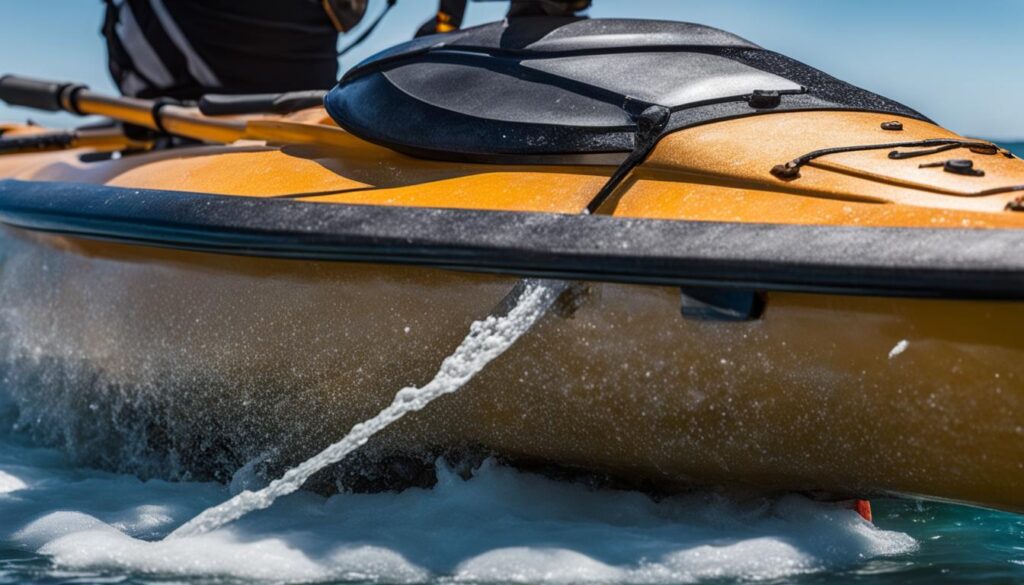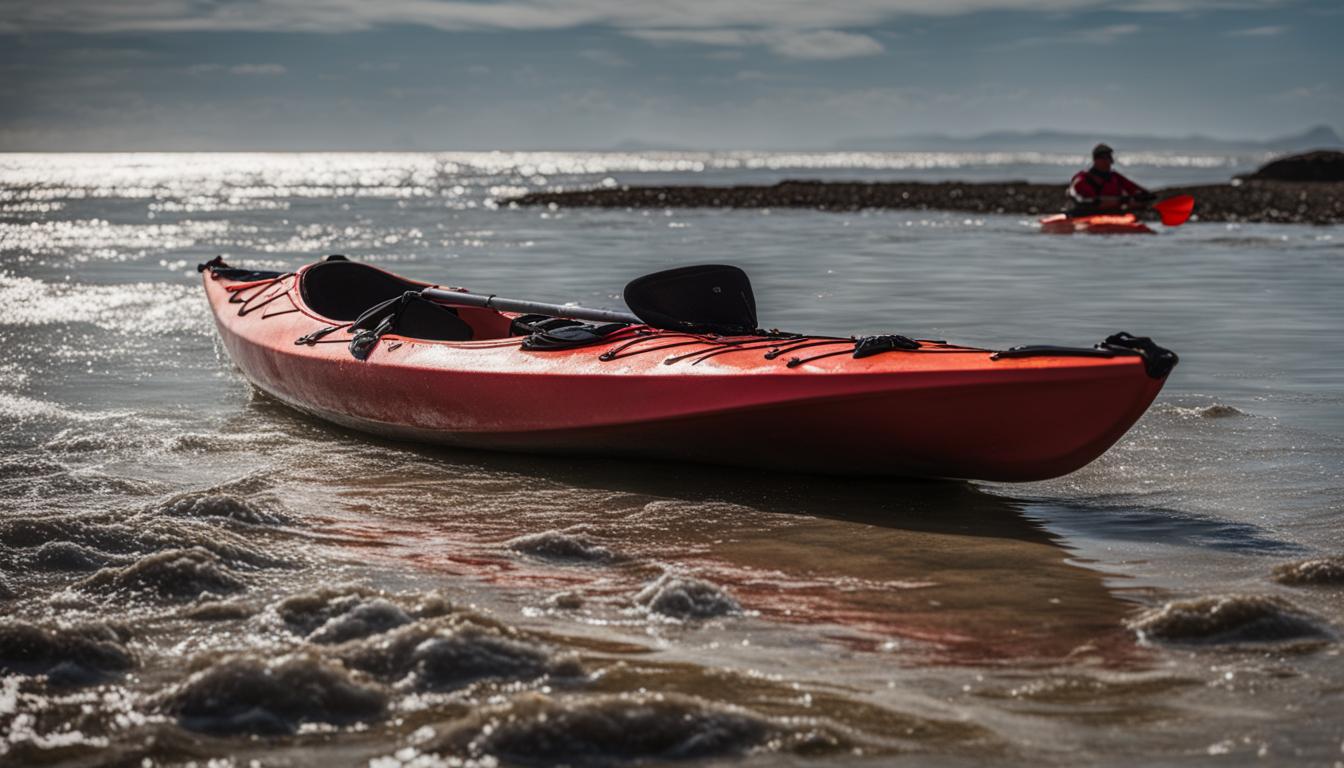Are you a sea kayaking enthusiast? Keeping your sea kayak in excellent condition is essential to ensure its longevity and performance. Regular maintenance and proper care will not only preserve the appearance of your kayak but also enhance your paddling experience. In this article, we will share valuable tips on sea kayak maintenance, upkeep, and cleaning to help you preserve your cherished watercraft for years to come.
Key Takeaways:
- Regular cleaning and maintenance are crucial for prolonging the lifespan of your sea kayak.
- Proper storage, both indoors and outdoors, can protect your kayak from the elements and prevent damage.
- Take care to clean all parts of your kayak, including the coaming, hatch interiors, and rod holders, to prevent debris buildup.
- Protect your kayak from UV damage by using UV protectant sprays or wax suitable for your kayak’s material.
- Perform routine maintenance checks and repairs, such as inspecting for holes, checking rigging, and ensuring your paddle and lifejacket are in good condition.
Proper Storage for Your Sea Kayak
Properly storing your sea kayak is crucial to preserving its longevity and maintaining optimal performance. By following these sea kayak storage tips, you can ensure that your kayak remains in top shape for years to come.
Choosing the Right Storage Location
When selecting a storage location for your sea kayak, it’s important to find a cool, dry area that is protected from the elements. If possible, store your kayak indoors to shield it from extreme weather conditions. However, if outdoor storage is your only option, choose a shaded area to minimize prolonged sun exposure, which can weaken the plastic materials.
Furthermore, when storing your kayak, it’s essential to keep it upside down. This positioning helps prevent water accumulation within the cockpit, protecting the internal components of your kayak from damage. Additionally, covering the cockpit with a durable and breathable material, such as a cockpit cover, will safeguard it from rain, snow, and potential pest infiltration.
Invest in Proper Kayak Storage Devices
Avoid placing your kayak directly on the ground, as this can lead to damage and deformation. Instead, use sawhorses, kayak racks, or wall-mounted cradles specifically designed for kayak storage. These devices provide stable support and prevent warping or stress on the hull of your sea kayak.
For long-term storage, consider using a weather-resistant tarp to cover your kayak completely. This extra layer of protection shields your kayak from dust, dirt, and potential mold or mildew growth. Secure the tarp tightly to prevent wind damage and ensure that the kayak remains well-protected throughout its storage period.
Preventing Theft
Sea kayaks can be an attractive target for theft, especially if stored outdoors or in easily accessible places. To safeguard your investment, make sure to secure your kayak using a high-quality kayak lock or cable. Fasten the lock to a stationary object, such as a sturdy post or railing, to prevent opportunistic theft.
Remember, proper storage is essential to preserving your sea kayak’s condition and maintaining its performance. By following these storage tips, you can ensure that your kayak remains in the best possible shape, ready for your next exciting paddling adventure.
Cleaning Your Sea Kayak
Regular cleaning is essential to keep your sea kayak in good condition. By following these maintenance tips, you can ensure that your kayak stays in peak performance for many years of enjoyable paddling.
When cleaning your sea kayak, start by rinsing it with a hose after each outing, especially if you paddle in saltwater or areas with significant algae or muck. This helps prevent corrosion of metal and rubber parts. Pay special attention to the coaming/cockpit rim, hatch interiors and covers, tracks, and rod holders, where sand and debris tend to accumulate.
Use a light soap and water solution to remove built-up dirt and stains, both on the outside and inside of the kayak. Avoid using abrasives that can cause damage. Gently scrub the surface with a soft sponge or cloth, focusing on any stubborn areas. Rinse thoroughly to remove any soap residue. Don’t forget to dry your kayak thoroughly before storing it to prevent moisture damage.
| Sea Kayak Cleaning Checklist |
|---|
| 1. Rinse your kayak with a hose after each outing. |
| 2. Pay special attention to areas where sand and debris accumulate. |
| 3. Use a light soap and water solution to remove dirt and stains. |
| 4. Avoid using abrasives that can cause damage. |
| 5. Dry your kayak thoroughly before storage. |
By regularly cleaning your sea kayak, you can ensure that it remains in top condition and maximizes its performance on the water. Remember to always follow the manufacturer’s guidelines for cleaning and maintenance, as specific types of kayaks may require different cleaning methods. Taking good care of your sea kayak will help you enjoy many memorable adventures for years to come.

Quote:
“A clean sea kayak is a happy sea kayak – and a happy paddler!” – Anonymous
Protecting Your Sea Kayak from UV Damage
Exposure to UV rays can cause damage to your sea kayak, especially if it’s made of plastic. To protect your kayak, use a UV protectant spray on both the outside and inside of the kayak. 303 Aerospace Protectant is a popular brand that helps mitigate the harmful effects of UV light. For fiberglass kayaks, consider using a fiberglass-suitable wax to protect the finish. Additionally, it’s important to shield your kayak from prolonged sun exposure by storing it in a shaded area or using a kayak cover. Taking these steps will help preserve the appearance and performance of your sea kayak.

When it comes to sea kayak maintenance, protecting your kayak from UV damage is crucial. UV rays can cause the plastic to degrade over time, leading to fading and weakening of the material. By using a UV protectant spray like 303 Aerospace Protectant, you can add a layer of defense against the sun’s harmful rays. This spray not only helps prevent fading and cracking but also provides a barrier against moisture, dirt, and other environmental factors.
In addition to using a UV protectant, consider storing your kayak in a shaded area or using a kayak cover to shield it from direct sunlight. Prolonged exposure to the sun can accelerate the deterioration of the plastic and compromise the integrity of your kayak. By keeping your kayak out of the sun when not in use, you can significantly extend its lifespan and keep it looking great.
Table: Comparison of UV Protection Products
| Product | Features | Application | Price |
|---|---|---|---|
| 303 Aerospace Protectant | UV protection, water resistance, non-greasy | Spray-on | $15-30 (depending on size) |
| Kayak UV Protectant | UV protection, restores color, prevents cracking | Spray-on or wipe-on | $10-20 |
| Boeshield T-9 | UV protection, rust prevention, lubrication | Spray-on | $10-20 |
When selecting a UV protectant, consider the specific needs of your kayak and personal preferences. Compare features, application methods, and prices to choose the product that best suits your needs. Remember to follow the manufacturer’s instructions for application and reapplication to ensure optimal protection for your sea kayak.
Performing Regular Maintenance on Your Sea Kayak
Maintaining your sea kayak requires regular upkeep and periodic checks to ensure its optimal performance and longevity. By performing routine maintenance, you can identify and address any issues before they worsen, preventing potential damage and costly repairs. Follow these essential tips to keep your sea kayak in top shape:
Inspecting for Damage
Regularly inspect your kayak for any signs of damage, such as holes, cracks, or dents. Begin and end each season with a thorough examination of the hull and the various components of your kayak. Focus on areas that are prone to wear and tear, like the bottom, edges, and the cockpit. If you discover any damage, promptly address it with suitable repair kits or seek professional assistance.
Checking Rigging and Equipment
Inspect all rigging elements, including handles, bungees, mounts, and cables, to ensure they are in good condition. Replace any broken or worn-out parts, as they can compromise the performance and safety of your kayak. Additionally, check the mounting tracks for dirt and debris, cleaning them thoroughly to maintain proper function. Verify that your paddle is clean and functioning correctly, as it directly affects your paddling experience.
Assessing Safety Gear
As part of your regular maintenance routine, assess the condition and functionality of your safety gear. Inspect your drybag contents and emergency kit, ensuring that everything is present and in proper working order. Furthermore, inspect your lifejacket to confirm it fits properly, and all straps, buckles, and flotation devices are intact. Replace any damaged or outdated safety gear to guarantee your safety on the water.
Performing Basic Repairs
Learn basic kayak repair techniques to address minor issues promptly. Familiarize yourself with the materials and tools needed for common repairs, such as patching holes or fixing leaks. This knowledge will enable you to handle small repairs independently, saving you time and money. However, for more complex repairs or if you are unsure, consult a professional kayak repair service.
| Maintenance Tips | Frequency |
|---|---|
| Inspect for damage | Begin and end of each season |
| Check rigging and equipment | Before each outing |
| Assess safety gear | Regularly |
| Perform basic repairs | As needed |
By following these maintenance practices, you can ensure your sea kayak remains in excellent condition, ready for your next kayaking adventure. Remember that proper maintenance not only extends the lifespan of your kayak but also enhances your overall experience on the water.
Conclusion
By following these maintenance tips, you can ensure that your sea kayak stays in peak condition for many years of enjoyable paddling. Regular cleaning, proper storage, and performing routine maintenance checks will help preserve the appearance and performance of your kayak. Remember to use the appropriate products for your kayak’s material, such as UV protectant for plastic kayaks and wax for fiberglass kayaks. Taking the time to care for your sea kayak will pay off in its longevity and your continued enjoyment on the water.
FAQ
How often should I clean my sea kayak?
It’s recommended to rinse your kayak with a hose after each outing, especially if you paddle in saltwater or areas with significant algae or muck. This helps prevent corrosion and keeps your kayak in good condition.
Can I use any soap to clean my kayak?
Yes, you can use a light soap and water solution to remove built-up dirt and stains. Just make sure to avoid using abrasives that can cause damage to your kayak.
How should I store my sea kayak?
It’s best to store your kayak in a cool, dry place that is protected from the elements. If you have to store it outdoors, choose a shaded area to avoid prolonged sun exposure. Make sure to store it upside down and cover the cockpit to protect it from rain, snow, and pests. Using storage devices like sawhorses or racks can help prevent damage.
How can I protect my kayak from UV damage?
To protect your kayak from UV rays, you can use a UV protectant spray on both the outside and inside of the kayak. Using a kayak cover or storing it in a shaded area can also help shield it from prolonged sun exposure.
What should I check during regular maintenance of my kayak?
During regular maintenance, you should inspect your kayak for any holes or damage that needs resealing or repair. Check all rigging, including handles, bungees, mounts, and cables, and replace any broken or worn-out parts. Inspect the mounting tracks for dirt and debris. Ensure your paddle is clean and functioning properly. Don’t forget to check your drybag contents and emergency kit, and ensure your lifejacket fits properly and is in good condition.





